Roadster Anti-Tramp Bar Issue
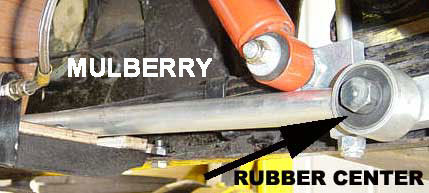 At
the beginning of the Roadster Series II production (early 2008), the MMC
made some modifications to the rear suspension. They attempted to address
an axle
wind-up issue that was causing the prop-shaft to impact the car in
its most extreme expression. Their original solution was to fit a single
Mulberry
anti-tramp bar on the right hand side of the car. These anti-tramp
bars were already being used in paired sets on racing Roadsters.
At
the beginning of the Roadster Series II production (early 2008), the MMC
made some modifications to the rear suspension. They attempted to address
an axle
wind-up issue that was causing the prop-shaft to impact the car in
its most extreme expression. Their original solution was to fit a single
Mulberry
anti-tramp bar on the right hand side of the car. These anti-tramp
bars were already being used in paired sets on racing Roadsters.
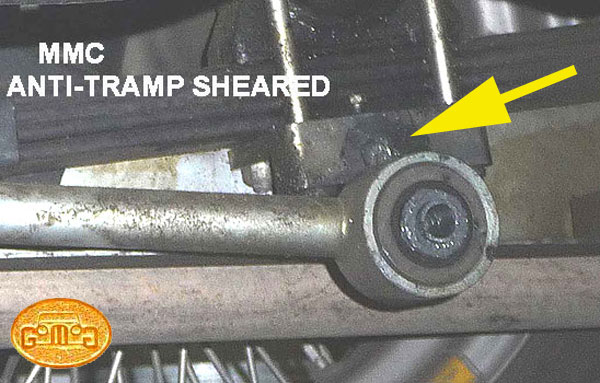 Traditionally,
anti-tramp bars are always fitted on both sides of a car. But it was felt
that a single bar would do the trick, cost less and the space on the right
is partially obstructed by the battery and its fittings. The first cars
with the Mulberry bars did well. Mulberry anti-tramp bars are designed
for Morgans. They are additionally unique as the end at the axle is fitted
with a compliant bush, press fit into the bar and through which a graded
metal attachment bolt is placed. This compliancy allows the suspension
to operate fully and freely, unlike many other anti-tramp solutions that
inhibit the up and down movement of the suspension.
Traditionally,
anti-tramp bars are always fitted on both sides of a car. But it was felt
that a single bar would do the trick, cost less and the space on the right
is partially obstructed by the battery and its fittings. The first cars
with the Mulberry bars did well. Mulberry anti-tramp bars are designed
for Morgans. They are additionally unique as the end at the axle is fitted
with a compliant bush, press fit into the bar and through which a graded
metal attachment bolt is placed. This compliancy allows the suspension
to operate fully and freely, unlike many other anti-tramp solutions that
inhibit the up and down movement of the suspension.
After the first few cars so fitted, the MMC decided to
copy the Mulberry design in hope of saving costs. In doing so, however,
they used different fittings and changed the all-important bush to something
less compliant. Anti-tramp bars on these Roadsters have a tendency to shear
their bolts at the axle saddle plate and bend or break their fitting bolts
at their front. The improper but most common solution is to greatly reinforce
the ends of the bars.
The MMC now makes the assembly with a more compliant bush
and higher graded fittings than these first copies. These are a better
idea for someone with this problem. The ideal fix would be to fit two quality
anti-tramp bars, one per side. assumijgn your lead fsprings are in order. (The
MMC had a forever run of iffy leaf springs.I changed those on my UK
Plus 8 four times in 6 years from 2005 to 2009).
I
have grave concerns on the long-term
affect of a single anti-tramp bar on what is a performance sports car.
If the massive tramp is sufficient to shear graded bolts that large, they
would have twisted the famous (and fragile) Morgan flexing chassis
before that. That will sadly change the handling and comportment of the
car, and most amateur drivers won't notice as it happens so
incrementally.
| N.B. There are ways to correct a Morgan chassis, in some
countries, there are professionals with equipment made for this purpose
that can do this perfectly (lazer-guided) and not cost an arm and
leg. |
SUSPENSION NOTE (EARLY
2009 TRADS)
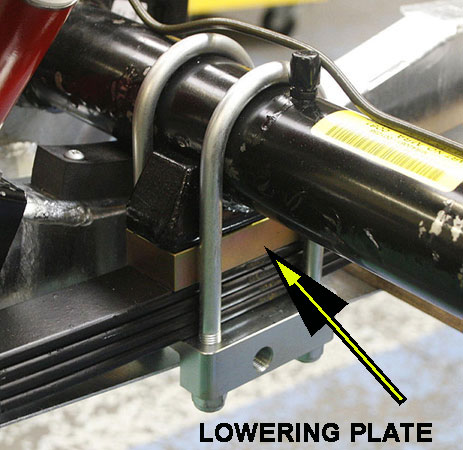
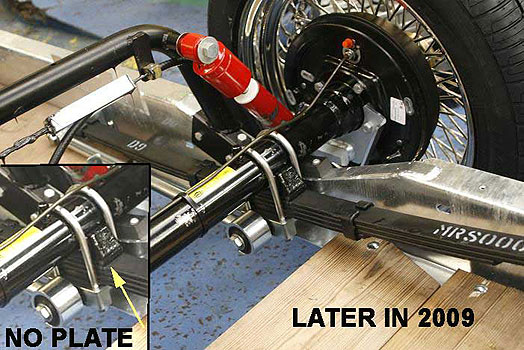 Sometime
in 2008, the MMC realized that their new 4 leaf rear springs were losing
their ride height, allowing the rear ends to prematurely sag to an unacceptable
degree. There seems to have been an attempt to address this first with
a higher arc specification but ultimately this did not provide the desired
result. At some point, the company turned to a new, higher quality
spring supplier with an excellent reputation. (And the cost of Morgan leaf
springs since doubled.) Apparently, on fitting the first batch of
these springs, it was immediately apparent that the arc specification given
the supplier was now too high. So as to use these springs, the company
fitted "lowering" plates between the leaf springs and the saddle plate.
These are used by racers to give a car a racing profile (see racing Roadsters).
In this case, they lower the ride to a more normal height.
Sometime
in 2008, the MMC realized that their new 4 leaf rear springs were losing
their ride height, allowing the rear ends to prematurely sag to an unacceptable
degree. There seems to have been an attempt to address this first with
a higher arc specification but ultimately this did not provide the desired
result. At some point, the company turned to a new, higher quality
spring supplier with an excellent reputation. (And the cost of Morgan leaf
springs since doubled.) Apparently, on fitting the first batch of
these springs, it was immediately apparent that the arc specification given
the supplier was now too high. So as to use these springs, the company
fitted "lowering" plates between the leaf springs and the saddle plate.
These are used by racers to give a car a racing profile (see racing Roadsters).
In this case, they lower the ride to a more normal height.
However,
in fitting these plates it is necessary to use longer u-bolts. Morgan rear
u-bolt length is very important. If they are too long, they will bend and
crack the thin horizontal flange at the ladder frame of the chassis.
If the thin flange is broken, a crack in the perpendicular "strength) section
of the frame soon follows. A SPECIAL NOTE must be attended to by these
owners. The newest leaf springs have the correct arc and ride height WITHOUT
this plate. When leaf spring replacement becomes necessary, the plate should
be discarded and NEW shorter u-bolts used rather than the originals with
these "transition" cars.
ROADSTER SUMPS
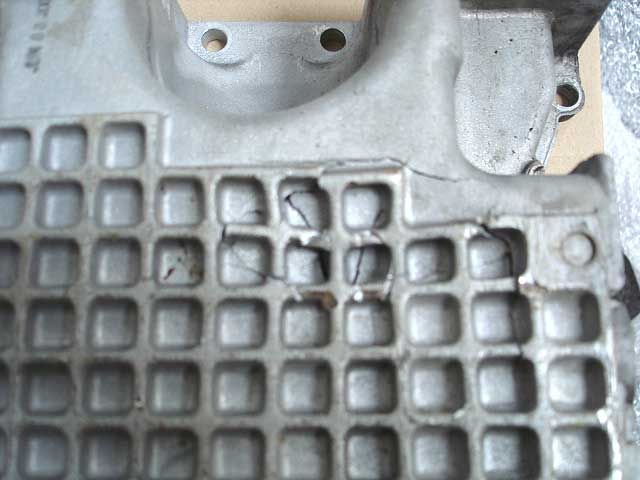
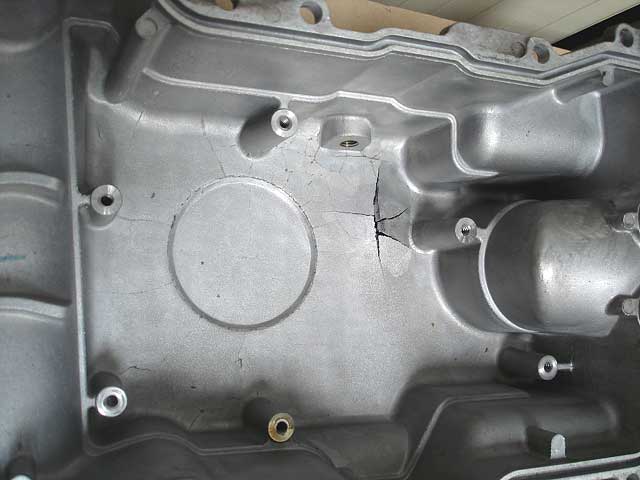 It is very easy to damage the Roadster sumps and much
more through a DDE (Deadly Domino Effect). The Roadster clearance at the
sump is only 3.35" on the right hand side and the sumps are made of cast
aluminum. Cast aluminum sumps can crack like egg-shells. The Plus 8s had
the same clearance and were frequently bottomed at the sumps as well. However,
they were made of steel (the Company did not long switch to aluminum sumps
as Land Rover did). Steel dents rather than cracks. It was/is a simple
matter to remove them and bang them out.
It is very easy to damage the Roadster sumps and much
more through a DDE (Deadly Domino Effect). The Roadster clearance at the
sump is only 3.35" on the right hand side and the sumps are made of cast
aluminum. Cast aluminum sumps can crack like egg-shells. The Plus 8s had
the same clearance and were frequently bottomed at the sumps as well. However,
they were made of steel (the Company did not long switch to aluminum sumps
as Land Rover did). Steel dents rather than cracks. It was/is a simple
matter to remove them and bang them out.
So
far, we have seen damage ranging from a cracked sump and a slow leak
(which
must be caught before severe internal engine damage occurs from oil
starvation)
all the way through a crack sufficiently large to instantly void the
engine
of oil and a domino impact that damages the gearbox, prop shaft and
differential. There is no steel sump available at the time of this
writing. So the best fix is that
of Peter Mulberry at Mulfab. Mulberry
increases the clearance at the right side by cutting down the sump. The
cost is very reasonable, and there is no waiting time as Peter inventories
pre-made replacements. Your old sump, in damaged or undamaged condition
will need to be traded.
WATCHPOINT: Another of the more dangerous aspects of this issue
is some of the solutions recommended publicly! Invariably, these aggravate
the problem by spreading the impact area and making other areas vulnerable to other types of damage that can be even more costly.
The worst of these (though there are many) I have seen thus far is that favored
by the Factory. They sell a "sump guard" which consists
of a very thick aluminum plate which straddles the bottom
front of the engine compartment and is attached to the car
frame at it weakest area, the thin
Morgan frame flange rather than attached at the thick
vertical section of the frame.
areas vulnerable to other types of damage that can be even more costly.
The worst of these (though there are many) I have seen thus far is that favored
by the Factory. They sell a "sump guard" which consists
of a very thick aluminum plate which straddles the bottom
front of the engine compartment and is attached to the car
frame at it weakest area, the thin
Morgan frame flange rather than attached at the thick
vertical section of the frame.
 Like
the aluminum sump itself, the aluminum plate will crack on impact and
if it doesn't it can split and surely bend the all-important frame
flange. When a Morgan frame flange
splits, it always leads soon to a frame crack in the vertical section
which should, properly, require an entire frame replacement. (ugh!) Additionally, equally silly, the plate stops before
the sump. As
the stock sump is closer to the ground than the flange, the protection
afforded the sump is illusory. To top this nonsense off, unlike
other sump guards used for the same engine in other vehicles, it blocks
the airflow from engine and engine bay, something all Morgans,
especially the Roadsters with their inadequate radiators, need very
badly. Here is an Alfa Romeo 105 sump guard available from many
sources, protecting the same sump in for THEIR Ford 3.0. Until
something better
comes along, I would recommend a combination of the Mulberry solution
with an Alfa Romeo guard. You will note that they warn against using the MMC/TalkMorgan solution? There is much at stake here. The guards
sell online, or through Alfa Romeo dealers for 35 to
50£. If it were me, I would have the long horizontal piece bent to be
bolted onto the vertical
sections of the frame on both sides as well as the flange (for
positioning) and use the rear bolts into the engine block or the
bell housing.
Like
the aluminum sump itself, the aluminum plate will crack on impact and
if it doesn't it can split and surely bend the all-important frame
flange. When a Morgan frame flange
splits, it always leads soon to a frame crack in the vertical section
which should, properly, require an entire frame replacement. (ugh!) Additionally, equally silly, the plate stops before
the sump. As
the stock sump is closer to the ground than the flange, the protection
afforded the sump is illusory. To top this nonsense off, unlike
other sump guards used for the same engine in other vehicles, it blocks
the airflow from engine and engine bay, something all Morgans,
especially the Roadsters with their inadequate radiators, need very
badly. Here is an Alfa Romeo 105 sump guard available from many
sources, protecting the same sump in for THEIR Ford 3.0. Until
something better
comes along, I would recommend a combination of the Mulberry solution
with an Alfa Romeo guard. You will note that they warn against using the MMC/TalkMorgan solution? There is much at stake here. The guards
sell online, or through Alfa Romeo dealers for 35 to
50£. If it were me, I would have the long horizontal piece bent to be
bolted onto the vertical
sections of the frame on both sides as well as the flange (for
positioning) and use the rear bolts into the engine block or the
bell housing.
SOURCING
To source a new sump, pre-2006 (aka Roadster I) sumps
are the same as those from either a Mondeo ST220 or a Jaguar S-Type (99).
They should be very easy to find at any break-up yard in the UK. Post-2006
(Roadster II) are a mildly different matter. The post-2006 Roadsters use
the engine from made-for-USA Ford entry level 4x4 called the Escape. From
memory, I think Morgan is the only company using them on the east side
of the Atlantic..so exact version used sumps will be an impossibility locally
for these. However, you will find both sumps easily enough in the US and
at reasonable prices. In all cases, a professional can adapt the earlier
version to a later Roadster.
Front Belt & Pulley
The Roadsters use a different belt and pulley than its
Ford Escape brethren.
Replacement parts are:
Pulley: Gates GNAT38008
Belt: Gates K060747
 At
the beginning of the Roadster Series II production (early 2008), the MMC
made some modifications to the rear suspension. They attempted to address
an axle
wind-up issue that was causing the prop-shaft to impact the car in
its most extreme expression. Their original solution was to fit a single
Mulberry
anti-tramp bar on the right hand side of the car. These anti-tramp
bars were already being used in paired sets on racing Roadsters.
At
the beginning of the Roadster Series II production (early 2008), the MMC
made some modifications to the rear suspension. They attempted to address
an axle
wind-up issue that was causing the prop-shaft to impact the car in
its most extreme expression. Their original solution was to fit a single
Mulberry
anti-tramp bar on the right hand side of the car. These anti-tramp
bars were already being used in paired sets on racing Roadsters.
 Traditionally,
anti-tramp bars are always fitted on both sides of a car. But it was felt
that a single bar would do the trick, cost less and the space on the right
is partially obstructed by the battery and its fittings. The first cars
with the Mulberry bars did well. Mulberry anti-tramp bars are designed
for Morgans. They are additionally unique as the end at the axle is fitted
with a compliant bush, press fit into the bar and through which a graded
metal attachment bolt is placed. This compliancy allows the suspension
to operate fully and freely, unlike many other anti-tramp solutions that
inhibit the up and down movement of the suspension.
Traditionally,
anti-tramp bars are always fitted on both sides of a car. But it was felt
that a single bar would do the trick, cost less and the space on the right
is partially obstructed by the battery and its fittings. The first cars
with the Mulberry bars did well. Mulberry anti-tramp bars are designed
for Morgans. They are additionally unique as the end at the axle is fitted
with a compliant bush, press fit into the bar and through which a graded
metal attachment bolt is placed. This compliancy allows the suspension
to operate fully and freely, unlike many other anti-tramp solutions that
inhibit the up and down movement of the suspension.

 Sometime
in 2008, the MMC realized that their new 4 leaf rear springs were losing
their ride height, allowing the rear ends to prematurely sag to an unacceptable
degree. There seems to have been an attempt to address this first with
a higher arc specification but ultimately this did not provide the desired
result. At some point, the company turned to a new, higher quality
spring supplier with an excellent reputation. (And the cost of Morgan leaf
springs since doubled.) Apparently, on fitting the first batch of
these springs, it was immediately apparent that the arc specification given
the supplier was now too high. So as to use these springs, the company
fitted "lowering" plates between the leaf springs and the saddle plate.
These are used by racers to give a car a racing profile (see racing Roadsters).
In this case, they lower the ride to a more normal height.
Sometime
in 2008, the MMC realized that their new 4 leaf rear springs were losing
their ride height, allowing the rear ends to prematurely sag to an unacceptable
degree. There seems to have been an attempt to address this first with
a higher arc specification but ultimately this did not provide the desired
result. At some point, the company turned to a new, higher quality
spring supplier with an excellent reputation. (And the cost of Morgan leaf
springs since doubled.) Apparently, on fitting the first batch of
these springs, it was immediately apparent that the arc specification given
the supplier was now too high. So as to use these springs, the company
fitted "lowering" plates between the leaf springs and the saddle plate.
These are used by racers to give a car a racing profile (see racing Roadsters).
In this case, they lower the ride to a more normal height.

 It is very easy to damage the Roadster sumps and much
more through a DDE (Deadly Domino Effect). The Roadster clearance at the
sump is only 3.35" on the right hand side and the sumps are made of cast
aluminum. Cast aluminum sumps can crack like egg-shells. The Plus 8s had
the same clearance and were frequently bottomed at the sumps as well. However,
they were made of steel (the Company did not long switch to aluminum sumps
as Land Rover did). Steel dents rather than cracks. It was/is a simple
matter to remove them and bang them out.
It is very easy to damage the Roadster sumps and much
more through a DDE (Deadly Domino Effect). The Roadster clearance at the
sump is only 3.35" on the right hand side and the sumps are made of cast
aluminum. Cast aluminum sumps can crack like egg-shells. The Plus 8s had
the same clearance and were frequently bottomed at the sumps as well. However,
they were made of steel (the Company did not long switch to aluminum sumps
as Land Rover did). Steel dents rather than cracks. It was/is a simple
matter to remove them and bang them out.

